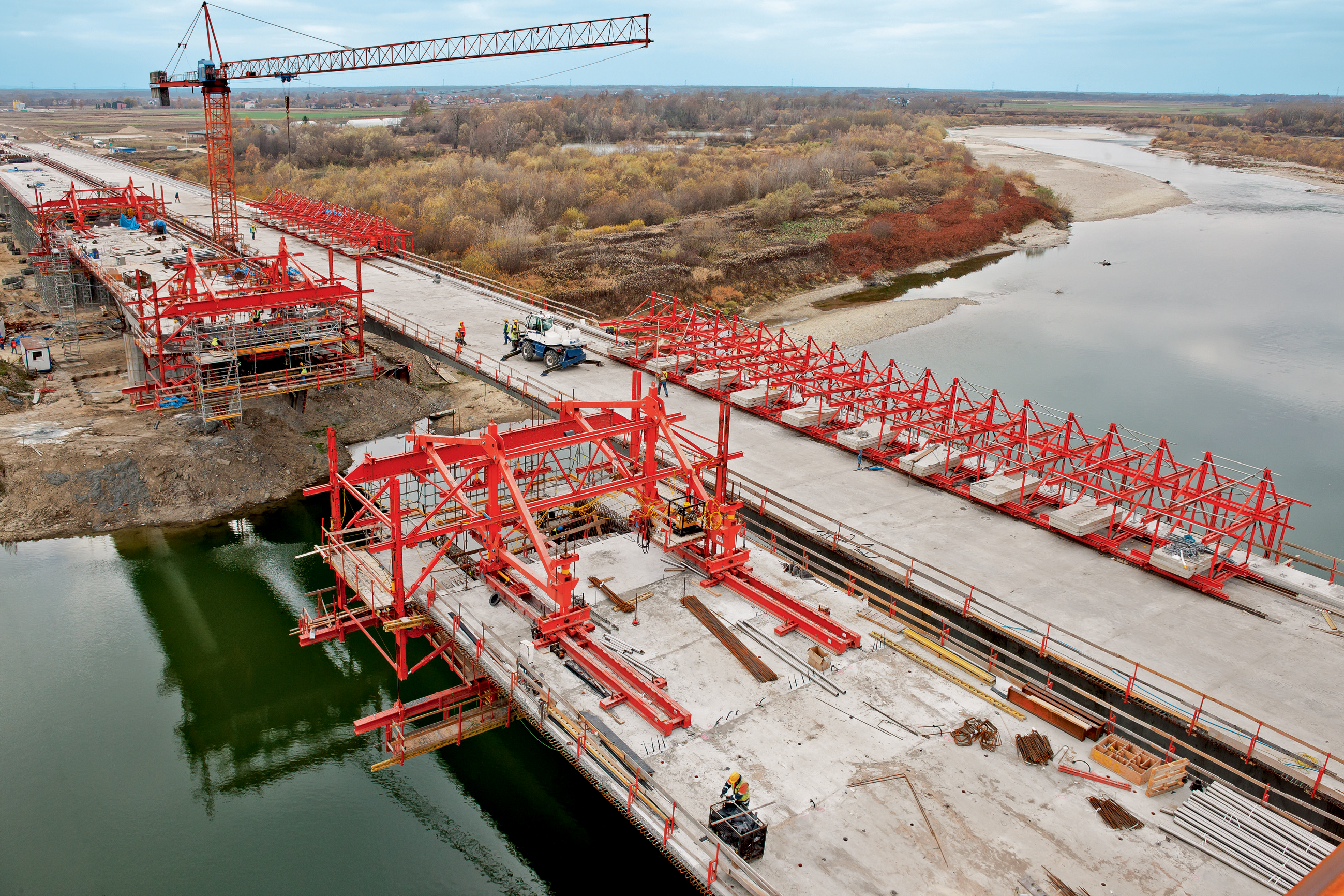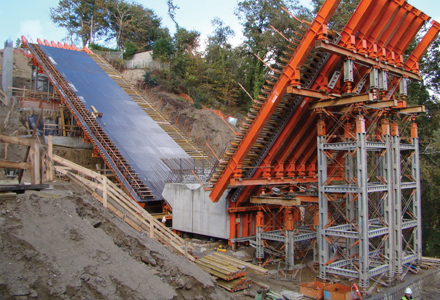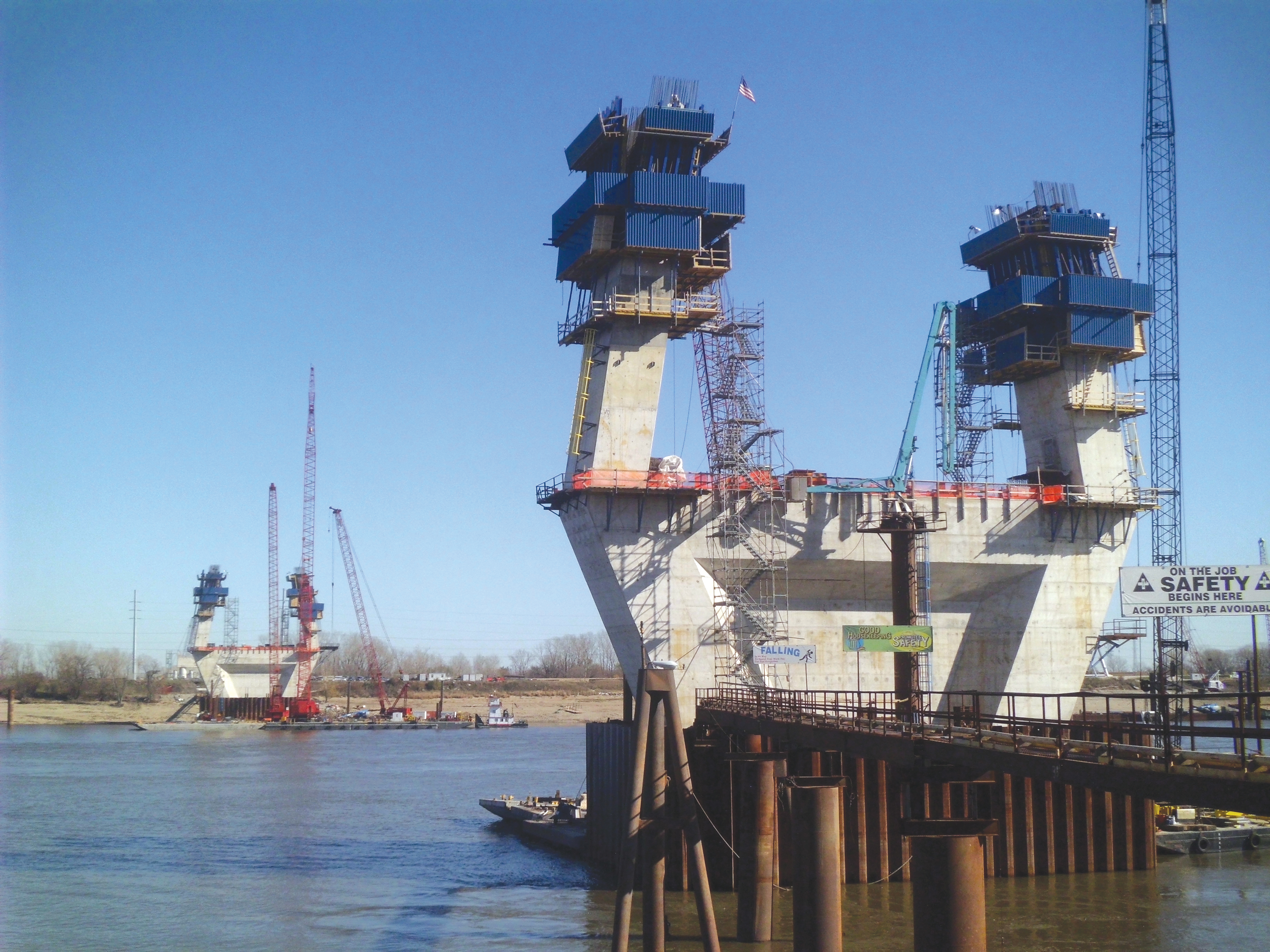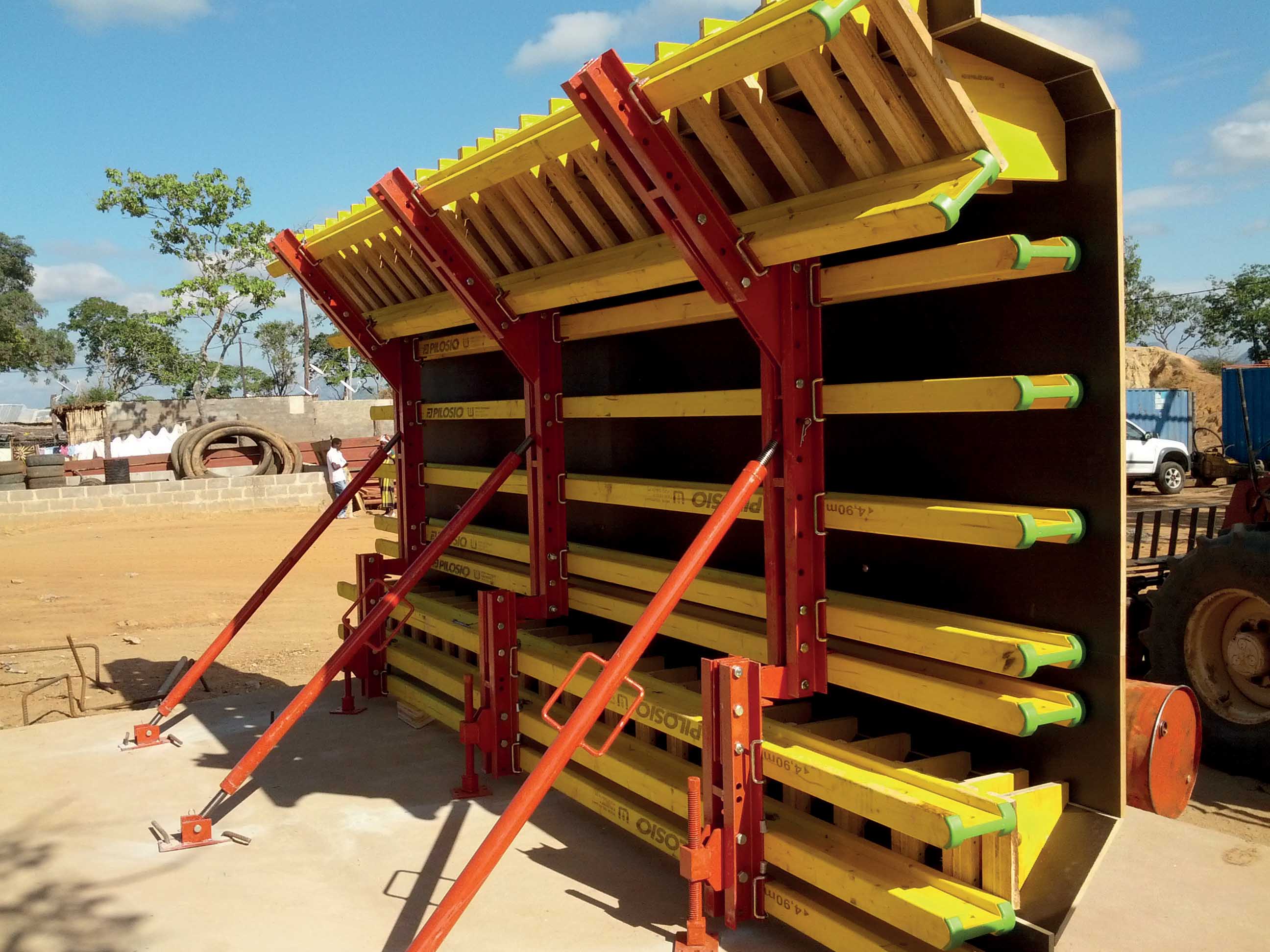
An 80m long wild game underpass is an innovative feature of the Route Nationale 88 (RN 88) expansion in south-west France.
For construction of the arched underpass tunnel, aConnecting Lyon and Toulouse, the RN 88 is being increased to four lanes in some areas. The wild game underpass element of the expansion works is being built near a nature reserve between the towns of Rodez and Albi. In order that the animals do not shy away from using the underpass, a very generous cross-section was planned for the 80m long structure.
A small stream also runs along the complete length of the 15m wide and 9.24m high, semi-circular tube which is being constructed above the bottom plate as a single unit using a cut-and-cover method.
For constructing the arched cross-section of the underpass tunnel with its 50cm wall thickness, PERI engineers in Meaux, near Paris, planned a solution based on the VARIOKIT engineering construction kit. The main components of the 10m long formwork carriage were SRU steel walers, HDT main beams and SLS heavy-duty spindles.
For the transfer of loads in the strip foundations, HD 200 heavy-duty props were used. The extensive utilisation of system components were said to significantly increase the cost-effectiveness of the formwork solution. Alongside the serial components were only a few purchased parts, such as couplings and timber formers, and consumable materials such as formlining.
PERI supplied pre-assembled formwork elements and platforms with up to 2.5m widths on a just-in-time basis to the jobsite. A supervisor supported the construction team during the final assembly of the formwork carriage directly onsite.
Due to the low number of uses of the formwork carriage, it was decided not to use hydraulic components for shuttering and striking or moving procedures. The main focus during the planning of the mechanical solution was on its ease of use.
For shuttering and striking, the construction team utilised simple spindles. In order to pivot the side elements inwards, only the lowest spindle was used. By releasing the heavy-duty wedges under the HDT girders, the entire formwork unit was lowered by around 8cm. In the subsequent casting segments, the formwork carriage was pulled by means of two winches with the flat and straight course of the tunnel simplifying this process.
Hydraulic jacks brought the formwork carriage into concreting position after moving, the side elements were then spindled upwards. Extensive prefabrication of the reinforcement sections directly next to the tube were said to accelerate their installation. A mobile crane moved the external formwork into position, consisting of two elements per side. Twelve concreting windows were used for placing the concrete, while compaction was carried out through internal vibrators.
Through the simple mechanical operations of the formwork carriage, the construction team was able to achieve a four-day cycle per concreting section after a very short familiarisation period.
Apart from the easy usability of the formwork carriage, PERI said the safety of site personnel had the highest priority. Among other things, the carriage had generously-sized working levels that were pre-assembled on the external formwork. SRU steel walers and GT 24 lattice girders formed the sub-structure of the platforms.
The construction site team was guaranteed secure working conditions through the 1.10m high PROKIT side mesh barrier which was fitted to all open edges.
The PROKIT system components allow open building edges to be reliably secured while requiring little installation effort. Only three system components are used – side mesh barrier, post and slab foot. The slab feet are screwed onto the wooden planking and accommodate the posts. These are self-locking and, as a result, can be quickly and safely installed. It is then said to be an easy task to attach the 2.4m long, powder-coated mesh barriers.
According to PERI, PROKIT EP 110 can be used very flexibly due to a wide range of fixing possibilities on walls and slabs, as well as being suitable for use on nearly all PERI formwork and scaffolding systems. Through the high utilisation rate of the individual components, the investment is said to pay for itself in the shortest possible time.
PERI said the VARIOKIT engineering construction kit can now be also used for the balanced cantilever construction method. For the building of a new 600m long motorway bridge near the Polish town of Tarnów, the new cantilevered construction equipment was used for the first time.
With VARIOKIT, the jobsite team achieved 4-5-day cycles for the up to 5m long concrete sections of the bridge.
PERI said VARIOKIT also ensured that tough requirements concerning the very small tolerances for the variable bridge cross-sections could be comfortably met. VARIOKIT’s compatibility with the PERI UP modular scaffold was said to ensure safe working platforms and access to all working areas.
Twelve pairs of piers support the two carriageways of the new motorway bridge, situated around 80km east of Krakow, each of which is 13m wide. Falsework carried the formwork for the hollow box superstructure of the foreland bridges – consisting of girder wall formwork elements together with the proven, high load-bearing GT 24 lattice girders. Depending on the support height and load, different PERI shoring solutions were used including ST 100 stacking towers as well as shoring towers on the basis of frame-connected MULTIPROP slab props.
The near 210m long section between the seventh and the 10th piers was realised in 48 casting segments using the balanced cantilevered method.
For this, building contractors Dragados used four cantilever construction units based on the VARIOKIT engineering construction kit. This equipment carries the fresh concrete loads into the supporting structure and moves the formwork from section to section.In order to handle the cross-section variations of the hollow box cross-sections, a formwork solution comprised of girder wall formwork was used.
PERI said one particular advantage of the new type of cantilevered construction solution is that all the components can be re-used in other civil engineering structures without requiring any further modifications.
As a result, the VARIOKIT engineer construction kit has a particularly broad field of applications with only a minimum of standard system components.
In addition, nearly all components are available in PERI rental park stocks. This is said to not only ensure fast availability of all components, but also increases the cost-effectiveness of the solutions for a construction company.
Remaining in Poland,
Work ahead of the major tournament, which Poland is hosting jointly with Ukraine, has been centred on the A1, A2 and A4 motorways, with Doka Polska involved with contractors Budimex in the later highways projects.
The main A4 motorway challenge was the need to fit 43 different bridge structures at almost the same time. A team of bridge specialists based in the engineering office at Doka Polska’s Katowice branch in Siemianowice slaskie prepared all the documentation for the formwork used on each site. In addition, Doka set up a logistics facility and warehouse in Ropczyce, exclusively for the A4 contract.
The majority of the structures were viaducts, and culverts cast in monolithic concrete. The abutments and pier-heads were cast in-situ using framed formwork Framax Xlife, while the bridge superstructures were formed using timber-beam formworks supported on load-bearing towers Staxo 100.
For the purposes of the contract, Doka Polska supplied more than 100,000 Staxo 100 frames and a great number of ‘H20 top’ beams.
To handle the entire contract and ensure adequate technical support, Doka Polska set up two teams of engineers and assigned a certified project manager, Wojciech Homik. With so many different subcontractors being involved in this project, it was decided to hold a series of training sessions for them on handling Doka Polska formwork and on the reconditioning-service quality criteria.
Doka Polska plans to establish a branch in Rzeszów, to provide reliable, fast specialist services and logistics to customers in south-eastern Poland.
The latest formwork safety innovations from Doka were showcased at City Hall in Dubai as part of the World Day for Safety and Health at Work on May 1, 2012.
Attended by more than 100 delegates, the event titled ‘360 Degree Formwork Safety Symposium’ included presentations from Gerald Hoermann, regional technical manager, Doka Middle East; and Alexander Macho, technical manager, Doka Gulf.
A discussion on building safely at heights, especially when wind and visibility are a regular factor in the Middle East, included a short case study on how Doka formwork systems had been applied to the successful construction of Dubai’s Burj Khalifa, the tallest building in the world.
RMD Kwikform Iberica (RMD KI) has designed, supplied and erected formwork and falsework for building the V2A and V2B viaducts on the Cámara de Lobos Expressway on the island of Madeira.
Made up of ten spans in total, creating and fitting the formwork and falsework was said by RMD KI to be far from a simple task. They had to maintain a curvature of 213.4m in the V2A viaduct’s first span, with the remainder being straight with a constant 12% longitudinal slope.
For the V2A viaduct, RMD KI devised a box type configuration of Superslim Soldiers, T200 wooden beams, and metal panels to act as a mould for the concrete pour. To overcome the 12% longitudinal incline that is consistent throughout the design of the viaduct, RMD KI engineers devised a bespoke formwork system to make the construction of the viaduct possible.
Harsco’s on time
Stephan Strothmann, leader of the SCF Group at Harsco Infrastructure Deutschland, said: “Work on the Hardanger Bridge made good progress over the last months. The formwork part for the construction of the pylons, which was accomplished with support from Harsco Infrastructure, was finished last year and according to schedule.
“The catwalks which are spanning the fjords are in place now. Also, the steel bridge deck elements have been manufactured. Eight sections with 60m length and 380tonnes of weight each, plus five sections with 45m length will be shipped from Shanghai to Hardanger this summer. They will be lifted once the main cable and the vertical hanger cables are in place.”
Strothmann said that the existing Hardanger Bridge [approach road] tunnel is currently having a new ventilation and lighting system fitted, with work also due to begin soon on new [approach road] tunnels to enhance highway access to the bridge.











